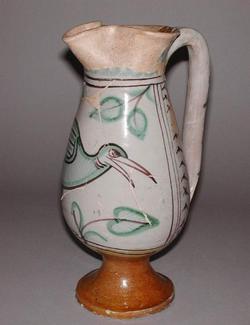Current Location: In storage
Maker(s)
Pottery:
Unidentified Orvieto pottery
(Probably)
Entities
Categories
Description
Late Medieval maiolica jug, painted in manganese and green with a bird on the front.
Pale buff earthenware. The interior and foot are lead-glazed yellowish-brown; the rest is tin-glazed pale greyish-white. Painted in manganese and copper-green.
Shape 17. Elongated piriform body with pedestal foot, short neck, trilobate mouth and loop handle.
The front is decorated with a long-legged bird with a pointed beak, with leaves above to right and left, and below to right. The handle is flanked by inverted Vs between two sets of three vertical lines. Below are two manganese bands; on the neck, two manganese bands, a green chain and another manganese band; and on the handle, eleven horizontal stripes of alternate colours.
Notes
History note: Signor Avvocato Marcioni or Cavaliere Capitano Lucatelli; Sotheby's, 16-17 February 1914, Catalogue of the collections of early Italian pottery formed by Signor Avvocato Marcioni and Cavaliere Capitano Lucatelli of Orvieto, lot 53 & pl. II. Purchased from Kerin, London, on 9 December 1933 by H.S. Reitlinger (d.1950); the Reitlinger Trust, Maidenhead, from which transferred in 1991.
Legal notes
H.S. Reitlinger Bequest, 1950; transferred from the Reitlinger Trust
Measurements and weight
Height: 27.0 cm
Height: 27.5 cm
Acquisition and important dates
Method of acquisition: Bequeathed
(1991-04-29)
by
Reitlinger, Henry Scipio
Dating
14th Century
Medieval
Circa
1300
CE
-
Circa
1400
CE
Note
The inverted V motifs down the sides are not typical of Orvieto jugs of this form and this jug may have come from elsewhere. The extremely smooth surface of the glaze, showing few defects under ultra-violet light, suggested doubts about its authenticity, but thermoluminescence analysis by the Oxford Research Laboratory for Archaeology and the History of Art (report dated 8 March 1994, sample 581m29) estimated that the sample was last fired between 350 and 650 years ago (1344-1644). Hence the good quality of the glaze may indicate that it was made later than some of the other jugs in the collection.
School or Style
Medieval
People, subjects and objects depicted
Components of the work
Decoration
composed of
high-temperature colours
( manganese and copper-green)
Interior, Foot
composed of
lead-glaze
Exterior
composed of
tin-glaze
Foot
Diameter 10.3 cm
Body
Diameter 12.5 cm
Front To Handle
Width 13.9 cm
Materials used in production
Earthenware
Inscription or legends present
Inscription present: circular with serrated edge
- Text: 273
- Method of creation: Inscribed in indelible pencil
- Type: Label
- Text: 53
- Location: On base
- Method of creation: In pencil
- Type: Inscription
References and bibliographic entries
Identification numbers
Accession number: C.63-1991
Primary reference Number: 47586
Packing number: EURCER 418
Stable URI
Audit data
Created: Saturday 6 August 2011
Updated: Tuesday 30 April 2024
Last processed: Wednesday 14 May 2025
Associated departments & institutions
Owner or interested party:
The Fitzwilliam Museum
Associated department:
Applied Arts





